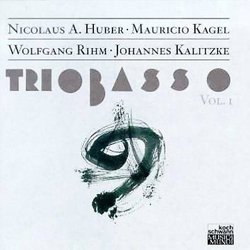| All Artists: Various Artists, Trio Basso Title: Trio Basso, Vol. I: Nicolaus A. Huber / Mauricio Kagel / Wolfgang Rihm / Johannes Kalitzke Members Wishing: 1 Total Copies: 0 Label: Koch Schwann (Germ.) Release Date: 1/5/1993 Genres: International Music, Classical Style: Number of Discs: 1 SwapaCD Credits: 1 UPC: 099923603924 |
Search - Various Artists, Trio Basso :: Trio Basso, Vol. I: Nicolaus A. Huber / Mauricio Kagel / Wolfgang Rihm / Johannes Kalitzke
 | Various Artists, Trio Basso Trio Basso, Vol. I: Nicolaus A. Huber / Mauricio Kagel / Wolfgang Rihm / Johannes Kalitzke Genres: International Music, Classical
|
Larger Image |
CD Details |
CD ReviewsLower end the better end scarecrow | Chicago, Illinois United States | 03/25/2005 (5 out of 5 stars) "Trio Basso is Joachim Krist,Viola, Othello Liesmann,Violoncello, and Wolfgang Guttler, Kontrabass,they have been around since the early Eighties playing music specifically for this Lower end strings,more overtones per square footage, and the mixture the synergy that occurs is formidable, it is like all the violence and brutality in strings resides here inhabits these three string instruments. The music they commission must have that extended dimension to it, plucked alternating with harmonics, snapped pizzicati, Am Steg, Sul ponticello,microintervals. The Huber piece is interesting, Huber is known for kurz, short durational procedures at work,"miniature" expressions; but here it is a bit longer than some of his one to two minutes pieces.Huber is strictly timbral composer,inhabiting classic shapes much of the time even predictable at its lower end, it is only timbre that conveys what he wants,melodies )if used) are like parodies, like leftovers from another age, how he wants the music to proceed, and here with slight political reference the work is threadbare at times, allowing for the beauty to come through with this combination. Likewise the Kalitzke work is a bit more predictable,more safe nothing ventured nothing gained here, it has a more impassioned dimension to it, like the leftovers of early modernity, with deep brooding melos exhibited. The Kagel taps into more the popular materials, more lighthearted here yet not abandoning the large pallette of timbre required for the Trio Basso to even consider your work. Rihm writes the most imaginative string music there is, his various string quartets attest to that,he is the equivalent neo-expressionist quite popular for German culture with the painters Georg Baselitz, Sigmar Polke (more playful iconoclast) Rihm's music sometimes sounds as if Brahms had endured through the Second World War.Melody is in the forefront of the narrative,nostalgic, melodramatic at times yet Rihm negates the obvious the predictable and prefers to mount graphics effects,as a negative part of this narrative, sort of cancells things out 'scary' type gestures.Adorno said someplace that this penchant for the "shock" only seems to deteriorate the proceedings,that modernity has lived a better life already."
|

 Track Listings (16) - Disc #1
Track Listings (16) - Disc #1